Instruction
Fancy Footwork For Solid Iron Shots
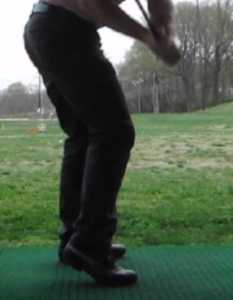
So much time in golf instruction is spent focusing on the hips, shoulders and arms that many amateur golfers are never taught the proper footwork necessary for a powerful, repeatable golf swing.
One reason for this is because good footwork is subtle, which makes it harder to identify on great golfers. The most common footwork issue I see (pictured right) in students is the heel of the trail foot tends to lift and move the entire trail leg towards the golf ball.
Not only does this promote spinning the lower body out of control, it also makes the down swing steeper and more susceptible to shots off the heel or the club. So let’s resolve this problems with the drills below!
The Grip Drill
Grab your self an extra club and place it on the ground perpendicular to the target line. Now place the edge of your trail foot on the grip.
From this position make a few practice swings. If you notice your heel rising with your toes and pressing into the grip, you’re doing it incorrectly. The feel you are looking for is on the instep of your foot rather than your toes. The longer you maintain contact with the grip, on the instep the better.
Toes Up
Another drill to combat bad foot work is the “Toes Up” drill. Much like the Grip Drill, the Toes Up drill will help eliminate the tendency to lunge towards the ball with your body and legs on the downswing.
This drill is simple and requires no training aids at all. First, take your toes on both feet and press them into the tops of the shoes. Then keep them there for the entirety of the golf swing.
By doing this, you are forcing your center of mass away from your toes and onto your heels, which eliminates the desire to lunge towards the ball on the down swing.
No Shoes
There is so much technology put into golf shoes today that for many they can add a false sense of stability during the golf swing.
Because of this, many golfers don’t realize the importance of the connection to the ground is during the swing. To combat stability issue and learn the proper sequencing of the feet and lower body, I recommend taking off your shoes and hitting some golf balls without them.
What you will find is that the first few shots you attempt to hit will feel dramatically different. You may potentially slip and lose your footing; you may even struggle to make contact on the first few shots. Don’t worry though — it is just your bodies’ way of finding its natural balance. As you continue to hit balls with no shoes on, you should be concentrating on your balance and getting into a good finish position on every swing. The more your balance improves the better your ball striking will become.
If you struggle with your finish, balance or ball striking it may be related to improper footwork throughout your golf swing. Try out the Grip Drill, Toes Up Drill and No Shoes Drill and not only will your footwork get better, your overall game is sure to improve as well.
- LIKE11
- LEGIT6
- WOW0
- LOL1
- IDHT0
- FLOP1
- OB0
- SHANK2
Instruction
Clement: Laid-off or perfect fade? Across-the-line or perfect draw?

Some call the image on the left laid off, but if you are hitting a fade, this could be a perfect backswing for it! Same for across the line for a draw! Stop racking your brain with perceived mistakes and simply match backswing to shot shape!
- LIKE0
- LEGIT0
- WOW0
- LOL0
- IDHT0
- FLOP0
- OB0
- SHANK1
Instruction
The Wedge Guy: The easiest-to-learn golf basic

My golf learning began with this simple fact – if you don’t have a fundamentally sound hold on the golf club, it is practically impossible for your body to execute a fundamentally sound golf swing. I’m still a big believer that the golf swing is much easier to execute if you begin with the proper hold on the club.
As you might imagine, I come into contact with hundreds of golfers of all skill levels. And it is very rare to see a good player with a bad hold on the golf club. There are some exceptions, for sure, but they are very few and very far between, and they typically have beat so many balls with their poor grip that they’ve found a way to work around it.
The reality of biophysics is that the body moves only in certain ways – and the particulars of the way you hold the golf club can totally prevent a sound swing motion that allows the club to release properly through the impact zone. The wonderful thing is that anyone can learn how to put a fundamentally sound hold on the golf club, and you can practice it anywhere your hands are not otherwise engaged, like watching TV or just sitting and relaxing.
Whether you prefer an overlap, interlock or full-finger (not baseball!) grip on the club, the same fundamentals apply. Here are the major grip faults I see most often, in the order of the frequency:
Mis-aligned hands
By this I mean that the palms of the two hands are not parallel to each other. Too many golfers have a weak left hand and strong right, or vice versa. The easiest way to learn how to hold the club with your palms aligned properly is to grip a plain wooden ruler or yardstick. It forces the hands to align properly and shows you how that feels. If you grip and re-grip a yardstick several times, then grip a club, you’ll see that the learning curve is almost immediate.
The position of the grip in the upper/left hand
I also observe many golfers who have the butt of the grip too far into the heel pad of the upper hand (the left hand for right-handed players). It’s amazing how much easier it is to release the club through the ball if even 1/4-1/2″ of the butt is beyond the left heel pad. Try this yourself to see what I mean. Swing the club freely with just your left hand and notice the difference in its release from when you hold it at the end of the grip, versus gripping down even a half inch.
To help you really understand how this works, go to the range and hit shots with your five-iron gripped down a full inch to make the club the same length as your seven-iron. You will probably see an amazing shot shape difference, and likely not see as much distance loss as you would expect.
Too much lower (right) hand on the club
It seems like almost all golfers of 8-10 handicap or higher have the club too far into the palm of the lower hand, because that feels “good” if you are trying to control the path of the clubhead to the ball. But the golf swing is not an effort to hit at the ball – it is a swing of the club. The proper hold on the club has the grip underneath the pad at the base of the fingers. This will likely feel “weak” to you — like you cannot control the club like that. EXACTLY. You should not be trying to control the club with your lower/master hand.
Gripping too tightly
Nearly all golfers hold the club too tightly, which tenses up the forearms and prevents a proper release of the club through impact. In order for the club to move back and through properly, you must feel that the club is controlled by the last three fingers of the upper hand, and the middle two fingers of the lower hand. If you engage your thumbs and forefingers in “holding” the club, the result will almost always be a grip that is too tight. Try this for yourself. Hold the club in your upper hand only, and squeeze firmly with just the last three fingers, with the forefinger and thumb off the club entirely. You have good control, but your forearms are not tense. Then begin to squeeze down with your thumb and forefinger and observe the tensing of the entire forearm. This is the way we are made, so the key to preventing tenseness in the arms is to hold the club very lightly with the “pinchers” — the thumbs and forefingers.
So, those are what I believe are the four fundamentals of a good grip. Anyone can learn them in their home or office very quickly. There is no easier way to improve your ball striking consistency and add distance than giving more attention to the way you hold the golf club.
More from the Wedge Guy
- The Wedge Guy: Golf mastery begins with your wedge game
- The Wedge Guy: Why golf is 20 times harder than brain surgery
- The Wedge Guy: Musings on the golf ball rollback
- LIKE87
- LEGIT13
- WOW6
- LOL1
- IDHT0
- FLOP4
- OB1
- SHANK8
Instruction
Clement: Stop ripping off your swing with this drill!

Not the dreaded headcover under the armpit drill! As if your body is defective and can’t function by itself! Have you seen how incredible the human machine is with all the incredible feats of agility all kinds of athletes are accomplishing? You think your body is so defective (the good Lord is laughing his head off at you) that it needs a headcover tucked under the armpit so you can swing like T-Rex?
- LIKE0
- LEGIT2
- WOW2
- LOL0
- IDHT0
- FLOP0
- OB0
- SHANK2
-

 19th Hole2 weeks ago
19th Hole2 weeks agoDave Portnoy places monstrous outright bet for the 2024 Masters
-

 19th Hole5 days ago
19th Hole5 days agoJustin Thomas on the equipment choice of Scottie Scheffler that he thinks is ‘weird’
-

 19th Hole3 weeks ago
19th Hole3 weeks agoTiger Woods arrives at 2024 Masters equipped with a putter that may surprise you
-

 19th Hole5 days ago
19th Hole5 days ago‘Absolutely crazy’ – Major champ lays into Patrick Cantlay over his decision on final hole of RBC Heritage
-

 19th Hole2 weeks ago
19th Hole2 weeks agoTwo star names reportedly blanked Jon Rahm all week at the Masters
-

 19th Hole2 weeks ago
19th Hole2 weeks agoReport: LIV Golf identifies latest star name they hope to sign to breakaway tour
-

 19th Hole2 weeks ago
19th Hole2 weeks agoNeal Shipley presser ends in awkward fashion after reporter claims Tiger handed him note on 8th fairway
-

 19th Hole1 week ago
19th Hole1 week agoBrandel Chamblee has ‘no doubt’ who started the McIlroy/LIV rumor and why

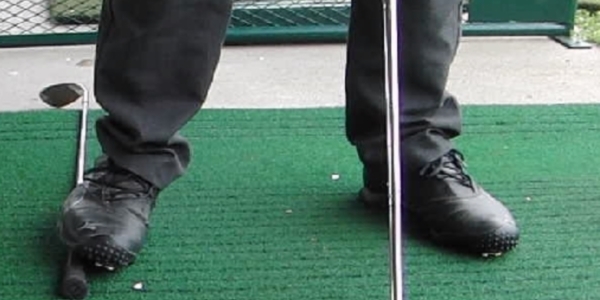
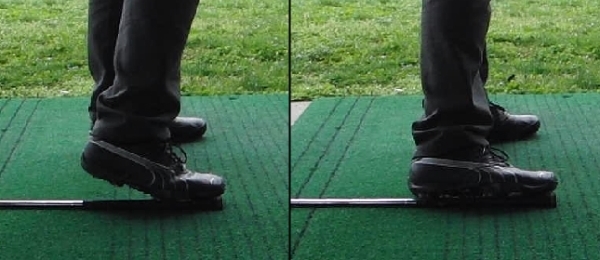
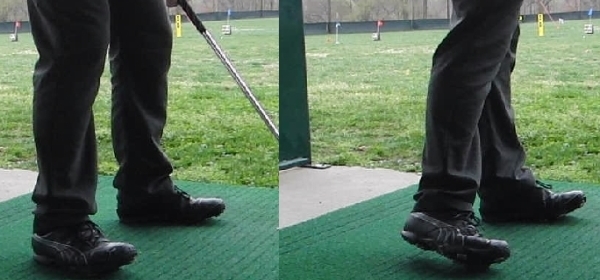
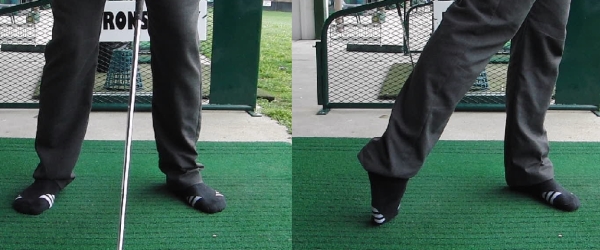















Ken
Apr 24, 2013 at 7:32 pm
Funny that this was just written as I was at the driving Range trying to keep my rear foot flat on the ground as I noticed that my knee was going towards the ball.
Question: How do I prevent myself from”sliding” my hips as opposed to turning them using this method
Scott Yurgalevicz
Apr 29, 2013 at 11:33 am
Hi Ken,
Great question. The problems isn’t really sliding vs. rotating, its that we don’t want the trail leg moving towards the ball to start the downswing. By feeling that rear heel on the ground for a bit longer it will prevent you from over rotating the hips during your transition, which is the real problem.
Hope that clears things up. Thanks for the comment!
Ben Pittman
Apr 24, 2013 at 9:28 am
Great point about footwork! To expand the thought a little, I have recently been focusing on my footwork. But rather than the right foot, my focus is on my left (front foot). Video shows that I lift and open my front foot during the transition – it causes my hips to open too much too soon and results in a very low right shoulder and an inside out swing with little release. Not surprisingly the miss is high right. It also indicates that my weight has shifted excessively to the right side. Keeping the left foot solid on the ground has allowed for a better release and posture – the ball flight is flatter and turning over.
Young Yoon
Apr 23, 2013 at 10:16 pm
Great,Great Awesome!! tips.
I didn’t realize that there are my foot end of my body. Thanks.
Steve Solomon
Apr 23, 2013 at 5:36 pm
Great advice. A few years ago I was playing a round with a Tour Player (now on Senior Tour). He gave me a great tip on the 18th Tee (I wish it was on the 2nd Tee!). Anyway, he said “don’t ever let your right heel get in front of your left big toe.” In other words, I wasn’t maintaining proper foot work and although I didn’t “spin out” on my shots, it was just enough to cause inconsistency.
I placed another ball on the tee and tried it out and I could tell what a difference in maintaining proper balance and I’ve used this advice ever since then with great results.
Scott, thanks for teaching on this neglected area of the golf swing.